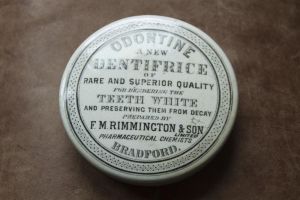Felix Marsh Rimmington (1818-97)
Felix Rimmington was for 25 years the analytical chemist for Bradford. In todays terms he would be best described as an early forensic scientist. Unlike many of the wool barons and other wealthy industrialists buried in Undercliffe whose vast empires are long gone Felix’s legacy lives on. Rimmingtons chemists on Bridge Street with its elegent Victorian frontage is located close to City Hall and still offers to this day both dedicated healthcare products and service as the company has done for the past 180 years. At one time Felix also owned another chemist shop on Manningham Lane close to Thorncliffe Road. It was just off Thorncliffe Road at Back Mellor St on 29 December 1888 (Innocents Day) that the mutilated remains of 7 year old little John Gill was found. The murder was dubbed as the work of Jack the Ripper initially and still remains unsolved to this day. Felix applied his analytical chemistry to analyse the young boys stomach contents and various other aspects of the crime. In effect Felix was applying science in the pursuit of justice. As early as 1858 Felix’s name was associated with early forensic science for when the Humbug Billy Arsenic poisonings occurred in Bradford it was he who uncovered the reason why so many died from this unprecedented tragedy. Rimmington was able to confirm that each sweet contained 14 grains of arsenic which was more than enough to destroy life. His work was instrumental in the passing of the adulteration of food and Act in 1860. The act empowered magistrates to impose fines for selling adulterated food and drink and enabled local authorities to employ public analysts to assist in this work. Felix was laid to rest in the plot numbers half of E168 +169 (consecrated) on the 19th of June 1897






